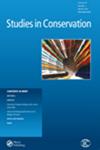The Nucleus of Color: Analysis of Hélio Oiticica’s Studio Materials
IF 0.8
4区 化学
0 ARCHAEOLOGY
引用次数: 1
Abstract
ABSTRACT A collection of studio materials belonging to the Brazilian neo-concrete artist Hélio Oiticica (1937–1980) was analyzed to identify the pigments and binding media present in paint mixtures created by the artist and in Brazilian house, artist, and craft paints. The labels on some of the paint mixtures link them to specific artworks, including Invenções 6, 12, 23, and 34 (1959–1962), and Penetrável 1 (1961), and although the artworks themselves were not available for analysis, Oiticica’s methodical journals include paint recipes for these objects. The findings reveal that Oiticica used a relatively narrow range of red and yellow pigments in the mixtures, and the majority of the paint mixtures appear to be oil or oils mixed with alkyds, sometimes with additional additives, including fungicides and extenders. The journal notes are often brief and incomplete, listing only a few paint mixtures for a given work, although many more paint mixtures exist in the collection. These samples, the only physical legacy remaining for much of Oiticica’s work that was destroyed in a 2009 fire, offer an unparalleled glimpse into the materials used by this seminal artist and suggest a greater complexity to his works than has thus far been appreciated. GRAPHICAL ABSTRACT色彩的核心:Hélio Oitica工作室材料分析
本文分析了巴西新混凝土艺术家h里奥·奥伊提卡(1937-1980)的工作室材料,以确定艺术家创作的颜料混合物中存在的颜料和结合介质,以及巴西房屋、艺术家和工艺油漆。一些油漆混合物上的标签将它们与特定的艺术品联系起来,包括Invenções 6、12、23和34(1959-1962),以及Penetrável 1(1961),尽管艺术品本身无法用于分析,但Oiticica的系统日志包括这些物品的油漆配方。研究结果表明,Oiticica在混合物中使用了相对狭窄的红色和黄色颜料,大多数油漆混合物似乎是油或与醇酸混合的油,有时还添加了其他添加剂,包括杀菌剂和扩展剂。日记笔记通常简短而不完整,只列出了一幅给定作品的几种颜料混合物,尽管收藏中有更多的颜料混合物。这些样品是Oiticica在2009年的一场大火中被毁的大部分作品仅存的实物遗产,为我们提供了对这位开创性艺术家使用的材料的无与伦比的一瞥,并表明他的作品比迄今为止所认识的更复杂。图形抽象
本文章由计算机程序翻译,如有差异,请以英文原文为准。
求助全文
约1分钟内获得全文
求助全文
来源期刊

Studies in Conservation
化学-分析化学
CiteScore
1.80
自引率
12.50%
发文量
73
审稿时长
>12 weeks
期刊介绍:
Studies in Conservation is the premier international peer-reviewed journal for the conservation of historic and artistic works. The intended readership includes the conservation professional in the broadest sense of the term: practising conservators of all types of object, conservation, heritage and museum scientists, collection or conservation managers, teachers and students of conservation, and academic researchers in the subject areas of arts, archaeology, the built heritage, materials history, art technological research and material culture.
Studies in Conservation publishes original work on a range of subjects including, but not limited to, examination methods for works of art, new research in the analysis of artistic materials, mechanisms of deterioration, advances in conservation practice, novel methods of treatment, conservation issues in display and storage, preventive conservation, issues of collection care, conservation history and ethics, and the history of materials and technological processes. Scientific content is not necessary, and the editors encourage the submission of practical articles, review papers, position papers on best practice and the philosophy and ethics of collecting and preservation, to help maintain the traditional balance of the journal. Whatever the subject matter, accounts of routine procedures are not accepted, except where these lead to results that are sufficiently novel and/or significant to be of general interest.
 求助内容:
求助内容: 应助结果提醒方式:
应助结果提醒方式:


